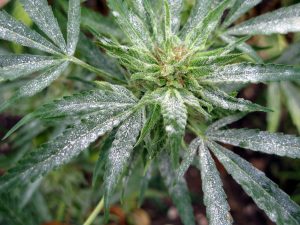
Grey mold is probably the most common type of mold that occurs in indoor plants and many outdoor gardens. This mold is prevalent in moist, warm climates. Damage from botrytis cannabis is compounded by humid climates, above 50%.
At first, it will be hard to spot but will start with a light white-greyish to a bluish-green color. It looks hair-like and similar to laundry lint in moist climates.
Grey mold is dry to the touch and crumbles if rubbed so grey mold spores are everywhere so they can easily affect your cannabis plants.
Even though it is most common on buds, it will also show on stems, leaves, and seeds that will cause dampening-off and decomposes buds. It can also be transmitted via seeds from one garden to another.
Watch for single leaves that dry out on the buds, this could be a signal of botrytis cannabis occurring within the buds. It is good to constantly watch for botrytis cannabis especially in the last several weeks before harvest.
Flowering buds can be quickly reduced to slime when the bud mold is attacking them. Stem damage starts on stems and not buds; it is less common indoors than outdoors.
First, a stem turns yellow and then grows cankerous development then causing damage to the wound to wilt as well as causing the stems to fold. Botrytis cannabis is transported by air and contaminated hands that spreads very quickly indoors.
Minimize Bud Mold Attacks

To minimize attacks, ensure the humidity is low (50% or less), and air circulation and ventilation flow well around and out of the room. Botrytis cannabis needs UV light to be able to complete its life cycle.
Spraying is advised if the problem is rampant across the garden and in high-risk areas. Avoid planting plants too close together since having them too close to each other will be harder to detect the plants, and the humidity between plants can be higher with transpiration.
Plants with excessive nitrogen and phosphorus tend to be less likely to attract grey mold, and if a plant has it then add some extra fertilizer and cut it out.
Use alcohol-sterilized pruners to remove infected botrytis cannabis and wash the pruners after removing the infected buds, since this can very quickly and easily transmit the mold to another plant. Wash hands or throw away gloves after using them.
If you increase the temperature to 80° F (26° C) and lower the humidity to below 50%, this will help prevent the mold from growing anymore.
Be sure to cut out not just the molded part, but also a little bit around it to make sure you get rid of the mold and spores from the bud. Some good biological items you can apply to your plants are Gliocladium roseum and Trichoderma species applied to the soil or plant.
A Bordeaux mixture keeps the early stages of grey mold in check as long as it is present on the leaves, but you do not want to spray when buds are starting to develop. Captan® is commonly used to protect seeds from botrytis cannabis.
Let us know what you think.




Responses